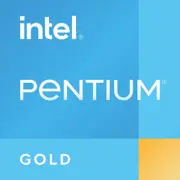Intel Pentium Gold G5500T

Intel Pentium Gold G5500T: Budget Processor for Basic Tasks (April 2025)
Key Features: Coffee Lake Architecture in a Compact Format
The Intel Pentium Gold G5500T, released in 2018, remains a popular budget solution thanks to its balance of price and energy efficiency.
- Architecture: Coffee Lake (14 nm). Despite the outdated manufacturing process, the chip is optimized for low power consumption.
- Cores and Threads: 2 cores / 4 threads (Hyper-Threading). Base frequency — 3.2 GHz (no turbo mode).
- Cache: L3 — 4 MB. Sufficient for simple applications, but limited for complex tasks.
- Graphics: Intel UHD Graphics 630 (base frequency — 350 MHz, maximum — 1.05 GHz). Supports 4K@60 Hz via HDMI/DisplayPort.
- TDP: 35 W. Ideal for compact systems without active cooling.
Key Features:
- Support for Intel Quick Sync Video technology for fast video encoding.
- Compatibility with Windows 11 (requires enabling TPM 2.0 on the motherboard).
- Low price: a new processor can be found for $50–60 (2025).
Compatible Motherboards: LGA 1151 v2 Socket and Selection Nuances
The G5500T uses the LGA 1151 v2 socket but requires 300-series chipsets:
- H310/B365: Budget boards (ASRock H310CM-HDV, ~$60). Suitable for office PCs, but limited in memory overclocking.
- H370/Z390: Boards with support for USB 3.1 Gen2 and PCIe 3.0 x16 (e.g., MSI Z390-A PRO, ~$120).
Important:
- Boards with H310/B360 chipsets may require a BIOS update to work with Coffee Lake.
- Avoid motherboards for the 100/200 series (e.g., H270) — they are incompatible.
Supported Memory: DDR4 and Optimization
The processor works with DDR4:
- Officially: up to 2400 MHz (on H310/B365 chipsets).
- Overclocking: On Z370/Z390, XMP profiles can be activated for 2666–3000 MHz.
Recommendations:
- Use a dual-channel configuration (2×8 GB DDR4-2400) — this will boost the integrated graphics performance by 15–20%.
- 8 GB is enough for office tasks; 16 GB is recommended for multimedia.
Power Supply: Minimum Cost
Considering the 35 W TDP and the absence of a discrete graphics card:
- Basic Scenario: A 300 W power supply (e.g., EVGA 300W, ~$40).
- With Headroom: If planning to install a GTX 1650 level GPU, choose a 450 W PSU (Corsair CX450, ~$65).
Tip: Even for a budget build, opt for power supplies with an 80 Plus Bronze certification — they are more reliable and save energy.
Pros and Cons of Pentium Gold G5500T
Pros:
- Energy Efficiency: A PC with this processor can be built in a book-sized case.
- Integrated Graphics: UHD 630 handles 4K video and older games (e.g., GTA V on low settings — 25–30 FPS).
- Price: One of the lowest on the market (cheaper than Ryzen 3 2200G).
Cons:
- Only 2 cores: In 2025, this is insufficient for multitasking (streaming + gaming) or modern applications optimized for 4+ cores.
- No support for PCIe 4.0/5.0: NVMe drive speeds are limited.
Usage Scenarios: Who is the G5500T Suitable For?
1. Office PCs: Working with documents, browsing, Zoom. For example, a build based on G5500T + 8 GB DDR4 + 256 GB SSD will cost about ~$200.
2. Media Centers: Streaming 4K content via Plex or Kodi.
3. Casual Gaming: Minecraft, CS:GO, Dota 2 (up to 60 FPS on low settings).
4. Educational Projects: PCs for schools or home learning.
Limitations: Not suitable for video editing in DaVinci Resolve, 3D modeling, or running Cyberpunk 2077.
Comparison with Competitors
- AMD Athlon 3000G (2C/4T, Vega 3): Cheaper (~$45), but weaker in single-threaded tasks. UHD 630 is 10–15% faster than Vega 3.
- Intel Core i3-9100 (4C/4T): For $80–90, offers 4 cores, which is critical for multitasking.
- Ryzen 3 3200G (4C/4T, Vega 8): More powerful in gaming (~$70), but requires a more expensive motherboard (AM4).
Conclusion: The G5500T wins only in price and power consumption.
Build Tips
1. Case: Choose Mini-ITX (Fractal Design Node 202) or compact solutions.
2. Cooling: The stock cooler is sufficient, but for quiet operation, replace it with Noctua NH-L9i (~$45).
3. Storage: Make sure to include an SSD (Kingston A400 480 GB, ~$35) — an HDD will bottleneck even this processor.
4. Upgrade: Don't invest in an expensive motherboard — the G5500T will become a bottleneck for modern GPUs.
Final Conclusion: Who is the G5500T For?
This processor is a choice for those who:
- Are building a cheap PC for internet, movies, or study.
- Need a compact system (e.g., HTPC).
- Do not plan to run "heavy" programs or games.
Alternative: If the budget allows an extra $20–30, it's better to go for the Ryzen 3 3200G or a used Core i5 8th generation — they will offer more upgrade potential.
The Pentium Gold G5500T may not be the most powerful, but it is one of the most affordable processors of 2025. It should only be considered for ultra-budget scenarios where every $10 counts.
Basic
CPU Specifications
Memory Specifications
GPU Specifications
Miscellaneous
Benchmarks
Compared to Other CPU
Share in social media
Or Link To Us
<a href="https://cputronic.com/en/cpu/intel-pentium-gold-g5500t" target="_blank">Intel Pentium Gold G5500T</a>